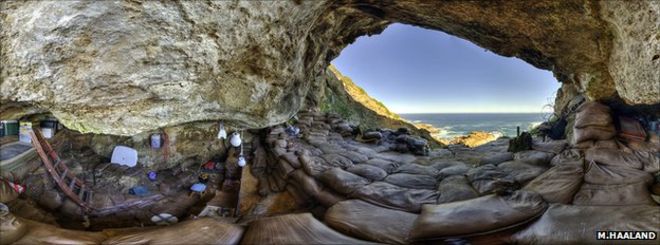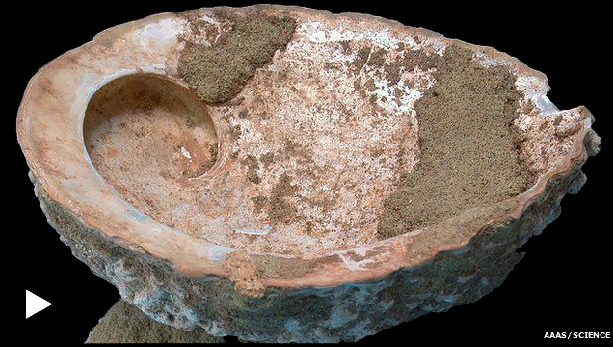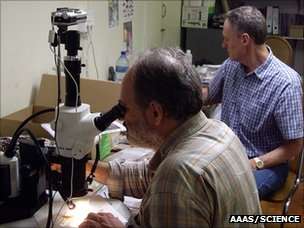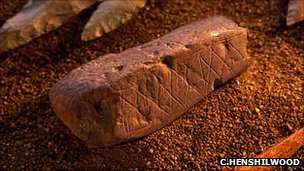By Jonathan Amos Science correspondent, BBC News (October 13, 2011).

The kits used by humans 100,000 years ago to make paint have been found at the famous archaeological site of Blombos Cave in South Africa.
The hoard includes red and yellow pigments, shell containers, and the grinding cobbles and bone spatulas to work up a paste – everything an ancient artist might need in their workshop. This extraordinary discovery is reported in the journal Science. It is proof, say researchers, of our early ancestors’ complexity of thought.
“This is significant because it is pushing back the boundaries of our understanding of when Homo sapiens – people like us – first became modern,” said Prof Christopher Henshilwood from the University of the Witwatersrand, Johannesburg. “These finds indicate that humans were certainly thinking in a modern way, in a way that is cognitively advanced, at least 100,000 years ago,” he told BBC News.

Blombos Cave on the southern Cape Coast, 300km east of Cape Town, has been giving up remarkable archaeological treasures for more than 20 years. Scientists have been scraping down through its sandy sediments to find all manner of artefacts left by the Middle Stone Age people who occupied the limestone cavity.
In 2002, researchers described 70,000-year-old blocks of ochre. This soft stone contains iron oxides that can be used as a pigment, or colouring agent.

But apart from some engravings on the blocks, there was little hard evidence to determine the precise purpose of the Blombos ochre. The new items seem to have had a much more obvious use – as the equipment to process paints.
The finds include abalone shells with ochre residues inside. There are tools made of quartzite that were presumably employed to hammer and grind ochre into a powder in the shells. And there is evidence that charcoal and oil from seal bones were being added to the mix. It seems bone implements were also being used to turn and lift the paint pastes.
All these artefacts were found together, almost as if someone had put them down intending to retrieve them at a later time, but then never coming back. Sands blown in through the cave entrance subsequently buried the kits and locked them away until they were excavated in 2008.
In the intervening three years, the finds have been subjected to a series of tests and assessments.
Ochre can have non-artistic applications such as an additive in glues, but co-researcher Francesco d’Errico from the University of Bordeaux says the analysis of the residues in the shells points strongly to the production of paints.

“The absence of a resin or a wax suggests the ochre was not used to make a glue or a mastic. We think it may have been used to make a paint or a design,” he explained.
Prof Henshilwood added: “It’s possible the paint was used to paint bodies, human skin. It could have been used to paint designs on leather or other objects. It could have been used for paintings on walls, although the surfaces of southern African caves are not ideal for the long-term preservation of rock art.”
The mere fact though that paints are being manufactured in a systematic way is indicative of a level of advanced thinking.
It would have required a high degree of planning to bring together all of the elements of the kits; and if art really was the purpose, it suggests the cave dwellers of Blombos were capable of symbolic thought – the ability to let one thing represent another in the mind.
This ability has been posited as the giant leap in human evolution that set our species apart from the rest of the animal world.
Understanding when and where this behaviour first emerged is a key quest for scientists studying human origins.
Until now, arguably the earliest examples of conceptual thinking were the pieces of shell jewellery discovered at Skhul Cave in Israel and from Oued Djebbana in Algeria.

These artefacts have been dated to 90,000-100,000 years ago. The Blombos paint kits now sit alongside these other finds.
Prof Chris Stringer from London’s Natural History Museum commented: “Twenty or 30 years ago, there was a view that Europe was really the place where all the big action was taking place – wonderful painted caves 30,000-35,000 years ago, and people decorating their bodies.
“We now know that this behaviour goes back far further in Africa; it goes back to 100,000 years, perhaps even more than 100,000 years.
“People were starting to express social identity in completely new ways. And there is a view that this behaviour is linked with complex language. So, it may indicate these people were communicating in a fully modern way,” he told BBC News.









